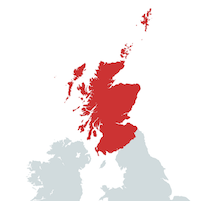
Map by mapchart.net - Some rights reserved.
Location
near Blackdykes, East Lothian, Scotland
Description
Tantallon Castle is located 3 miles south-east of North Berwick, in East Lothian, Scotland. It is built in an imposing position on a promontory opposite the Bass Rock, looking out onto the Firth of Forth. Tantallon is a curtain wall castle with a single wall blocking off the headland, with the other three sides protected by sea cliffs. The ruin is now in the care of Historic Scotland.
To the south-west, the massive 15m tall curtain wall blocks off the promontory forming an inner courtyard. The curtain wall has a tower at either end, and a heavily fortified tower gatehouse in the centre. There are several small chambers within the walls, and stairs accessing a parapet walk that connects the three towers. The northwest tower, known as the Douglas Tower, was circular and seven storeys high. The lowest storey was a pit prison. The East Tower is D-shaped and was originally five storeys high. The central gatehouse tower is square with four storeys of chambers. The main entrance ran through a passage below, protected by a drawbridge, three pairs of doors and a portcullis. There are two corner turrets, facing in toward the courtyard, where a 16th century spiral stair gives access to the head of the curtain wall. There is a north range of buildings running at right angles to the main curtain wall. The range is joined to the Douglas Tower of the main curtain wall. Alongside the curtain wall is a deep, rock-cut ditch.
History
Tantallon Castle was built in the mid 14th century by William Douglas, 1st Earl of Douglas and remained in the Douglas family for most of its history. In 1397 George Douglas, Earl of Angus (of the Red Douglases) married Mary the daughter of King Robert III, allying with the Royal House of Stewart. In 1482, The 5th Earl of Angus (Archibald "Bell the cat") conspired against James IV. In 1491 Tantallon Castle was besieged by James IV, but the Douglases submitted and the castle did not suffer extensive damage.
In 1525, the 6th Earl of Angus kidnapped the young King James V. In 1528, at age 16, King James V escaped and sent troops to attack Tantallon, which was besieged and bombarded with cannon for 20 days. The defensive ditch prevented the cannons being brought close enough to the walls to do serious damage. Angus fled to England, leaving the castle to James V. Tantallon was retained as a Royal fortress until James V died in 1542, when the Earl of Angus recovered it.
In 1650, Oliver Cromwell's forces invaded Scotland and laid siege to Tantallon bombarding it with cannon until a breach was made in the Douglas Tower. The Douglases surrendered and Tantallon was left in ruins and was never repaired or inhabited afterwards. The Douglases finally sold Tantallon in 1699, but the castle decayed further. In 1924, the castle was handed over to the UK Government Office of Works and is now in the care of Historic Scotland.
The Arts
Sir Walter Scott described the castle in his 1808 poem Marmion.
Other Castles in the Area
Borthwick Castle, Lothian
Crichton Castle, Midlothian
Dirleton Castle, Lothian
Dunbar Castle, Lothian
Fa'side Castle, East Lothian
Fenton Tower, Lothian
Hailes Castle, Lothian
Kellie Castle, Fife
Newark Castle, Fife
Pittarthie Castle, Fife
Scotstarvit Tower, Fife
|
|
|
|

